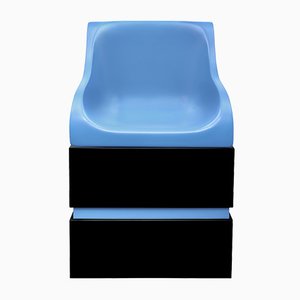Gufram celebrates its radical heritage with the Piper Collection
Learning at the Discotheque
The turbulent decades of the 1960s and '70s occupy an unforgettable place in the history of art and design—especially in Italy, where the Arte Povera and Radical Design movements emerged, cross-pollinated, and forever changed the international conversation around the relationship between culture and commerce. In the wake of the widespread anti-establishment protests of 1968, a generation of revolutionary Italian artists like Alberto Burri, Piero Manzoni, Alighiero Boetti, and Michelangelo Pistoletto, alongside architect-designer collectives like Studio 65, Sturm Group, Superstudio, and Archizoom, embraced unconventional materials and provocative aesthetics to call out the limitations of capitalism and advocate for a more humane (and less bourgeois) world.
For fans of this golden era of idealistic rebellion, Gufram remains a beloved touchstone. This edgy, nonconformist furniture brand was founded under the art direction of Italian designer Giuseppe Raimondi in the mid-1960s in Turin—the epicenter of Arte Povera and a vital hub for Radical Design. Disrupting the legacy of “Made in Italy” craftsmanship while introducing a Pop Art flair, Gufram collaborated with avant-garde creatives to produce some of the 20th century's most iconic designs, including the Bocca Sofa by Studio 65 (1970), the Pratone Lounge by Guido Ceretti, Piero Derossi, and Riccardo Rosso (1971), and the Cactus Coat Rack by Franco Mello and Guido Drocco (1972).
Though Gufram has seen ups and down over the decades, the current revival of interest in the Radical Design era has brought the 50-year-old company back into the spotlight—most recently with the re-launch of the Piper Collection, originally designed by Ceretti/Derossi/Rosso in 1966. Presented for the first time at the Artissima contemporary art fair in Turin last November, this chair design, charmingly subtitled Learning at the Discotheque, pays homage to the 50th anniversary of the Arte Povera movement, the birth of Radical Design, and the dynamic creative culture that inspired the designers behind these super groovy chairs.
Piper was not initially conceived for the commercial market, but was created for the famous discotheque of the same name, which was the unofficial headquarters of Turin's cutting-edge artists, architects, designers, musicians, and performers between 1966 and 1969. Through talks, concerts, performances, and exhibitions, the Piper Disco hosted and supported some of the era's most prominent creative minds. And along the way it became a symbol of experimental research, technological innovation, and more egalitarian aesthetics.
Viewed with contemporary eyes, the distinctive Piper design—so emblematic of its time—offers a nostalgia-fueled time machine to a potent moment in cultural history. Using historic photographs and original drawings from 1966, Gufram has faithfully recreated the chairs in the original Pop Art color palette of may green, sky blue, powder pink, and cadmium orange. The era’s signature Space Age vibe is captured in the generously proportioned, biomorphic, molded fiberglass seat set atop a cubic base that’s embellished with a simple colored band. It’s what the future used to look like and reminds us that forward-facing, progressive principles are much needed in design today.
While Gufram has been radical for half a century, the brand's Piper Collection has launched at a particularly auspicious moment, as the international design community has been taking a new look at 1960s and ’70s Radical Design. These days, a raft of designers and tastemakers are positing that many of the current political and social challenges we face could be ameliorated if we all embrace a little bit of the disruptive creativity and idealism that defined counterculture back then. We couldn’t agree more. The radicals who hung out at the Piper Disco still have a lot to teach us about working to make the world a better, brighter place.
—Gufram's new Piper Collection is available now exclusively through Pamono.
-
Text by
-
Carlotta Trevaini
Originally from Turin, Carlotta is part of our delightful sourcing team. She is also a big fan of urban art and coffee. Prior to arriving in Berlin in 2016, she spent time exploring Australia and studying politics and economics in Italy and the south of Germany. Though she misses seeing the Alps on the horizon, she loves Berlin’s inspiring creative scene as well as its “effortless, multicultural environment.”
-




